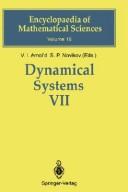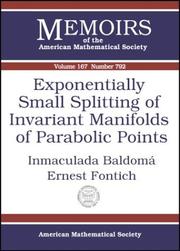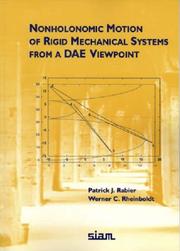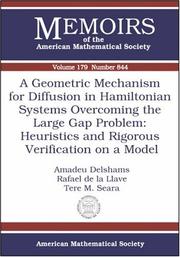| Listing 1 - 10 of 10 |
Sort by
|

ISBN: 3540181768 0387181768 3642057381 366206796X 9780387181769 Year: 1994 Volume: 16 Publisher: Berlin Springer
Abstract | Keywords | Export | Availability | Bookmark
 Loading...
Loading...Choose an application
- Reference Manager
- EndNote
- RefWorks (Direct export to RefWorks)
51 --- Mathematics --- Differentiable dynamical systems. --- Nonholonomic dynamical systems. --- 51 Mathematics --- Differentiable dynamical systems --- Nonholonomic dynamical systems --- Dynamical systems, Nonholonomic --- Non-holonomic systems --- Nonholonomic systems --- Differential dynamical systems --- Dynamical systems, Differentiable --- Dynamics, Differentiable --- Differential equations --- Global analysis (Mathematics) --- Topological dynamics
Book
ISBN: 1282761676 9786612761676 9814289493 9789814289498 9789814289481 9814289485 Year: 2010 Publisher: New Jersey World Scientific
Abstract | Keywords | Export | Availability | Bookmark
 Loading...
Loading...Choose an application
- Reference Manager
- EndNote
- RefWorks (Direct export to RefWorks)
This book gives a modern differential geometric treatment of linearly nonholonomically constrained systems. It discusses in detail what is meant by symmetry of such a system and gives a general theory of how to reduce such a symmetry using the concept of a differential space and the almost Poisson bracket structure of its algebra of smooth functions. The above theory is applied to the concrete example of Carathéodory's sleigh and the convex rolling rigid body. The qualitative behavior of the motion of the rolling disk is treated exhaustively and in detail. In particular, it classifies all mot
Nonholonomic dynamical systems. --- Geometry, Differential. --- Rigidity (Geometry) --- Caratheodory measure. --- Measure, Caratheodory --- Algebra, Boolean --- Measure theory --- Geometric rigidity --- Rigidity theorem --- Discrete geometry --- Differential geometry --- Dynamical systems, Nonholonomic --- Non-holonomic systems --- Nonholonomic systems --- Differentiable dynamical systems --- Rigidity (Geometry).
Book
ISBN: 0821815830 9780821815830 Year: 1972 Volume: 33 Publisher: Providence (R.I.): American Mathematical Society
Abstract | Keywords | Export | Availability | Bookmark
 Loading...
Loading...Choose an application
- Reference Manager
- EndNote
- RefWorks (Direct export to RefWorks)
Mathematical physics --- Classical mechanics. Field theory --- Dynamics --- Nonholonomic dynamical systems --- 51-74 --- 51 --- 681.3*J2 --- Dynamical systems --- Kinetics --- Mathematics --- Mechanics, Analytic --- Force and energy --- Mechanics --- Physics --- Statics --- Dynamical systems, Nonholonomic --- Non-holonomic systems --- Nonholonomic systems --- Differentiable dynamical systems --- Mathematics--?-74 --- Physical sciences and engineering (Computer applications) --- Nonholonomic dynamical systems. --- 681.3*J2 Physical sciences and engineering (Computer applications) --- 51 Mathematics --- 51-74 Mathematics--?-74 --- Solides. --- Solids. --- Systèmes non-holonomes. --- Mécanique --- Mécanique --- Systèmes non-holonomes.

ISBN: 0821834452 Year: 2004 Publisher: Providence (R.I.): American Mathematical Society
Abstract | Keywords | Export | Availability | Bookmark
 Loading...
Loading...Choose an application
- Reference Manager
- EndNote
- RefWorks (Direct export to RefWorks)
Ergodic theory. Information theory --- Ordinary differential equations --- 514.8 --- Geometric study of objects of mechanics and physics --- 514.8 Geometric study of objects of mechanics and physics --- Nonholonomic dynamical systems. --- Hamiltonian systems. --- Lagrangian points. --- Hamiltonian systems --- Lagrangian points --- Nonholonomic dynamical systems --- Dynamical systems, Nonholonomic --- Non-holonomic systems --- Nonholonomic systems --- Differentiable dynamical systems --- Equilibrium points, Lagrangian --- Lagrangian equilibrium points --- Libration points --- Points, Lagrangian --- Orbits --- Hamiltonian dynamical systems --- Systems, Hamiltonian

ISBN: 089871446X Year: 2000 Publisher: Philadelphia : SIAM,
Abstract | Keywords | Export | Availability | Bookmark
 Loading...
Loading...Choose an application
- Reference Manager
- EndNote
- RefWorks (Direct export to RefWorks)
This book contains a unique description of the nonholonomic motion of systems of rigid bodies by differential algebraic systems. Nonholonomic Motion of Rigid Mechanical Systems from a DAE Viewpoint focuses on rigid body systems subjected to kinematic constraints (constraints that depend on the velocities of the bodies, e.g., as they arise for nonholonomic motions) and discusses in detail how the equations of motion are developed. The authors show that such motions can be modeled in terms of differential algebraic equations (DAEs), provided only that the correct variables are introduced. Several issues are investigated in depth to provide a sound and complete justification of the DAE model. These issues include the development of a generalized Gauss principle of least constraint, a study of the effect of the failure of an important full-rank condition, and a precise characterization of the state spaces.
531.3 --- Differential-algebraic equations --- -Dynamics, Rigid --- Nonholonomic dynamical systems --- Dynamical systems, Nonholonomic --- Non-holonomic systems --- Nonholonomic systems --- Differentiable dynamical systems --- Rigid dynamics --- Algebraic-differential equations --- Differential-algebraic systems --- Equations, Algebraic-differential --- Equations, Differential-algebraic --- Systems, Differential-algebraic --- Differential equations --- Dynamics. Kinetics --- Numerical solutions --- Dynamics, Rigid. --- Nonholonomic dynamical systems. --- Numerical solutions. --- 531.3 Dynamics. Kinetics --- Dynamics, Rigid --- Numerical analysis --- Differentiable dynamical systems. --- Systèmes dynamiques --- Dynamics, rigid --- Dynamique des corps rigides
Book
ISBN: 3319086901 3319086898 Year: 2014 Publisher: Cham : Springer International Publishing : Imprint: Springer,
Abstract | Keywords | Export | Availability | Bookmark
 Loading...
Loading...Choose an application
- Reference Manager
- EndNote
- RefWorks (Direct export to RefWorks)
Nonholonomic systems are control systems which depend linearly on the control. Their underlying geometry is the sub-Riemannian geometry, which plays for these systems the same role as Euclidean geometry does for linear systems. In particular the usual notions of approximations at the first order, that are essential for control purposes, have to be defined in terms of this geometry. The aim of these notes is to present these notions of approximation and their application to the motion planning problem for nonholonomic systems.
Nonholonomic dynamical systems. --- Geometry, Differential. --- Differential geometry --- Dynamical systems, Nonholonomic --- Non-holonomic systems --- Nonholonomic systems --- Differentiable dynamical systems --- Systems theory. --- Global differential geometry. --- Artificial intelligence. --- Mathematics. --- Computer science. --- Systems Theory, Control. --- Differential Geometry. --- Artificial Intelligence. --- Mathematics, general. --- Computer Science, general. --- Informatics --- Science --- Math --- AI (Artificial intelligence) --- Artificial thinking --- Electronic brains --- Intellectronics --- Intelligence, Artificial --- Intelligent machines --- Machine intelligence --- Thinking, Artificial --- Bionics --- Cognitive science --- Digital computer simulation --- Electronic data processing --- Logic machines --- Machine theory --- Self-organizing systems --- Simulation methods --- Fifth generation computers --- Neural computers --- Geometry, Differential --- System theory. --- Differential geometry. --- Systems, Theory of --- Systems science --- Philosophy

ISBN: 0821838245 Year: 2006 Publisher: Providence American Mathematical Society
Abstract | Keywords | Export | Availability | Bookmark
 Loading...
Loading...Choose an application
- Reference Manager
- EndNote
- RefWorks (Direct export to RefWorks)
Ergodic theory. Information theory --- Ordinary differential equations --- Classical mechanics. Field theory --- 51 <082> --- 514.8 --- 51 <082.1> --- Mathematics--Feestbundels. Festschriften --- Geometric study of objects of mechanics and physics --- Mathematics--Series --- 514.8 Geometric study of objects of mechanics and physics --- 51 <082> Mathematics--Feestbundels. Festschriften --- Nonholonomic dynamical systems. --- Mechanics. --- Differential equations --- Mécanique --- Équations différentielles --- Qualitative theory. --- Théorie qualitative --- Mechanics --- Nonholonomic dynamical systems --- Dynamical systems, Nonholonomic --- Non-holonomic systems --- Nonholonomic systems --- Differentiable dynamical systems --- Classical mechanics --- Newtonian mechanics --- Physics --- Dynamics --- Quantum theory --- 517.91 Differential equations --- Qualitative theory --- 517.91 --- Numerical solutions --- Mécanique. --- Théorie qualitative. --- Numerical solutions&delete&
Book
ISBN: 3642099386 3540858466 9786612364143 1282364146 3540858474 Year: 2009 Publisher: Berlin ; London : Springer,
Abstract | Keywords | Export | Availability | Bookmark
 Loading...
Loading...Choose an application
- Reference Manager
- EndNote
- RefWorks (Direct export to RefWorks)
A general approach to the derivation of equations of motion of as holonomic, as nonholonomic systems with the constraints of any order is suggested. The system of equations of motion in the generalized coordinates is regarded as a one vector relation, represented in a space tangential to a manifold of all possible positions of system at given instant. The tangential space is partitioned by the equations of constraints into two orthogonal subspaces. In one of them for the constraints up to the second order, the motion low is given by the equations of constraints and in the other one for ideal constraints, it is described by the vector equation without reactions of connections. In the whole space the motion low involves Lagrangian multipliers. It is shown that for the holonomic and nonholonomic constraints up to the second order, these multipliers can be found as the function of time, positions of system, and its velocities. The application of Lagrangian multipliers for holonomic systems permits us to construct a new method for determining the eigenfrequencies and eigenforms of oscillations of elastic systems and also to suggest a special form of equations for describing the system of motion of rigid bodies. The nonholonomic constraints, the order of which is greater than two, are regarded as programming constraints such that their validity is provided due to the existence of generalized control forces, which are determined as the functions of time. The closed system of differential equations, which makes it possible to find as these control forces, as the generalized Lagrange coordinates, is compound. The theory suggested is illustrated by the examples of a spacecraft motion. The book is primarily addressed to specialists in analytic mechanics.
Mathematics -- Differential Equations -- General. --- Mathematics. --- Nonholonomic dynamical systems. --- Nonholonomic dynamical systems --- Civil Engineering --- Geometry --- Civil & Environmental Engineering --- Mathematics --- Engineering & Applied Sciences --- Physical Sciences & Mathematics --- Differentiable dynamical systems. --- Dynamical systems, Nonholonomic --- Non-holonomic systems --- Nonholonomic systems --- Differential dynamical systems --- Dynamical systems, Differentiable --- Dynamics, Differentiable --- Engineering. --- Mechanics. --- Computational intelligence. --- Mechanics, Applied. --- Theoretical and Applied Mechanics. --- Computational Intelligence. --- Applied mechanics --- Engineering, Mechanical --- Engineering mathematics --- Intelligence, Computational --- Artificial intelligence --- Soft computing --- Classical mechanics --- Newtonian mechanics --- Physics --- Dynamics --- Quantum theory --- Construction --- Industrial arts --- Technology --- Differentiable dynamical systems --- Differential equations --- Global analysis (Mathematics) --- Topological dynamics --- Mechanics, applied. --- Classical Mechanics.
Book
ISBN: 1493930168 1493930176 Year: 2015 Publisher: New York, NY : Springer New York : Imprint: Springer,
Abstract | Keywords | Export | Availability | Bookmark
 Loading...
Loading...Choose an application
- Reference Manager
- EndNote
- RefWorks (Direct export to RefWorks)
This book explores some of the connections between control theory and geometric mechanics; that is, control theory is linked with a geometric view of classical mechanics in both its Lagrangian and Hamiltonian formulations and in particular with the theory of mechanical systems subject to motion constraints. The synthesis of the topic is appropriate as there is a particularly rich connection between mechanics and nonlinear control theory. The book provides a unified treatment of nonlinear control theory and constrained mechanical systems and illustrates the elegant mathematics behind many simple, interesting, and useful mechanical examples. It is intended for graduate students who wish to learn this subject and researchers in the area who want to enhance their techniques. The book contains sections focusing on physical examples and elementary terms, as well as theoretical sections that use sophisticated analysis and geometry. The first four chapters offer preliminaries and background information, while the remaining five are broken down into chapters on nonholonomic mechanics, control and stabilization, optimal control, energy-based, and recent energy-based techniques for mechanical and nonholonomic systems. The second edition of the book extends many of the topics discussed in the first edition to incorporate both new research and more historical background. The additional material includes work on the Hamel equations and quasivelocities, discrete dynamics, bo th holonomic and nonholonomic, Hamiltonization, and the Hamilton-Jacobi equation. In addition new examples and exercises have been added. Review of earlier Edition (A.J. van der Schaft, IEEE Control System Magazine, 2005 ) This book can be read on many different levels and has been described as a “delightful book that will be valuable for both the control community and researchers” .
Operations Research --- Civil & Environmental Engineering --- Engineering & Applied Sciences --- Mathematics. --- Dynamics. --- Ergodic theory. --- System theory. --- Mechanics. --- Mechanics, Applied. --- Control engineering. --- Robotics. --- Mechatronics. --- Systems Theory, Control. --- Dynamical Systems and Ergodic Theory. --- Control, Robotics, Mechatronics. --- Theoretical and Applied Mechanics. --- Systems theory. --- Differentiable dynamical systems. --- Mechanics, applied. --- Applied mechanics --- Engineering, Mechanical --- Engineering mathematics --- Differential dynamical systems --- Dynamical systems, Differentiable --- Dynamics, Differentiable --- Differential equations --- Global analysis (Mathematics) --- Topological dynamics --- Nonholonomic dynamical systems. --- Control theory. --- Dynamics --- Machine theory --- Dynamical systems, Nonholonomic --- Non-holonomic systems --- Nonholonomic systems --- Differentiable dynamical systems --- Classical mechanics --- Newtonian mechanics --- Physics --- Quantum theory --- Mechanical engineering --- Microelectronics --- Microelectromechanical systems --- Automation --- Control engineering --- Control equipment --- Control theory --- Engineering instruments --- Programmable controllers --- Ergodic transformations --- Continuous groups --- Mathematical physics --- Measure theory --- Transformations (Mathematics) --- Dynamical systems --- Kinetics --- Mathematics --- Mechanics, Analytic --- Force and energy --- Mechanics --- Statics --- Systems, Theory of --- Systems science --- Science --- Philosophy

ISBN: 0691082286 0691082324 1400881579 Year: 1979 Publisher: Princeton (N.J.) Princeton university press
Abstract | Keywords | Export | Availability | Bookmark
 Loading...
Loading...Choose an application
- Reference Manager
- EndNote
- RefWorks (Direct export to RefWorks)
Based on a seminar sponsored by the Institute for Advanced Study in 1977-1978, this set of papers introduces micro-local analysis concisely and clearly to mathematicians with an analytical background. The papers treat the theory of microfunctions and applications such as boundary values of elliptic partial differential equations, propagation of singularities in the vicinity of degenerate characteristics, holonomic systems, Feynman integrals from the hyperfunction point of view, and harmonic analysis on Lie groups.
Mathematical analysis --- Differential geometry. Global analysis --- 517.98 --- -Advanced calculus --- Analysis (Mathematics) --- Algebra --- Functional analysis and operator theory --- Addresses, essays, lectures --- Mathematical analysis. --- Addresses, essays, lectures. --- -517.1 Mathematical analysis --- 517.98 Functional analysis and operator theory --- -Functional analysis and operator theory --- -517.98 Functional analysis and operator theory --- 517.1 Mathematical analysis --- 517.1. --- 517.1 --- Addition. --- Analytic function. --- Analytic manifold. --- Asymptotic analysis. --- Bernhard Riemann. --- Boundary value problem. --- Bounded operator. --- Cartan subgroup. --- Characterization (mathematics). --- Class function (algebra). --- Closed-form expression. --- Codimension. --- Cohomology. --- Compact space. --- Comparison theorem. --- Contact geometry. --- Continuous function. --- Continuous linear operator. --- Convex hull. --- Cotangent bundle. --- D-module. --- Degenerate bilinear form. --- Diagonal matrix. --- Differentiable manifold. --- Differential operator. --- Dimension (vector space). --- Dimension. --- Elliptic partial differential equation. --- Equation. --- Existence theorem. --- Fourier integral operator. --- Generic point. --- Group theory. --- Harmonic analysis. --- Holomorphic function. --- Holonomic. --- Homogeneous space. --- Hyperfunction. --- Hypersurface. --- Identity element. --- Irreducible representation. --- Killing form. --- Lagrangian (field theory). --- Lie algebra. --- Lie group. --- Linear differential equation. --- Locally compact space. --- Masaki Kashiwara. --- Maximal ideal. --- Monodromy. --- Natural number. --- Neighbourhood (mathematics). --- Ordinary differential equation. --- Orthogonal complement. --- Partial differential equation. --- Path integral formulation. --- Proper map. --- Pseudo-differential operator. --- Regularity theorem. --- Sigurdur Helgason (mathematician). --- Submanifold. --- Subset. --- Summation. --- Symmetric space. --- Symplectic geometry. --- Tangent cone. --- Theorem. --- Topological space. --- Vector bundle. --- Victor Guillemin. --- Weyl group. --- Analyse microlocale
| Listing 1 - 10 of 10 |
Sort by
|

 Search
Search Feedback
Feedback About UniCat
About UniCat  Help
Help News
News